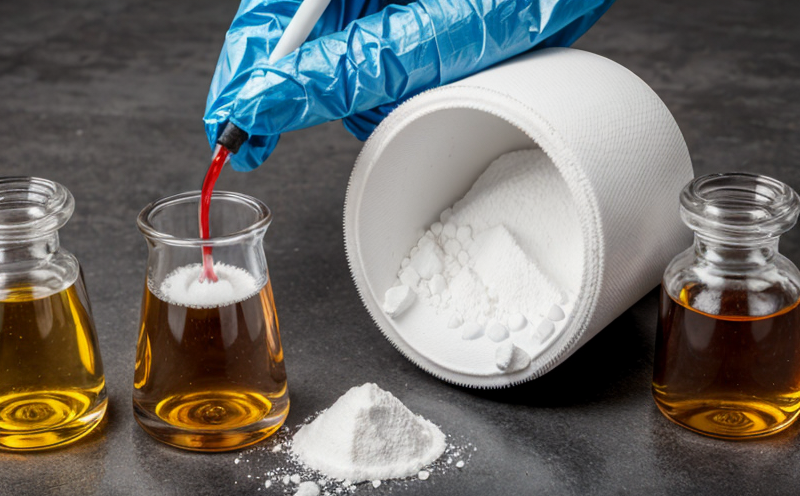REACH Regulation Annex XVII Restricted Substances Testing
The Registration, Evaluation, Authorisation and Restriction of Chemicals (REACH) regulation was established in the European Union to ensure a high level of protection for human health and the environment. REACH applies to all chemicals used or manufactured in quantities above one tonne per year, and it aims to identify the intrinsic properties of chemical substances that may present a risk during production, use, or disposal.
One critical aspect of this regulation is Annex XVII, which lists specific substances whose placing on the market and use are restricted. These restrictions are enforced by national authorities in member states who ensure compliance through inspections and audits. The list includes over 500 chemical substances that pose significant risks to human health or the environment.
Our service specializes in providing comprehensive testing for these restricted substances as outlined in Annex XVII, ensuring that our clients are compliant with EU regulations. This testing is essential not only for manufacturers and importers but also for suppliers who wish to ensure their products meet stringent environmental standards before entering the European market.
Our approach begins with a thorough review of your product specifications and intended use cases. We then select the appropriate analytical methods based on the nature of the material or chemical being tested. For many of these substances, traditional qualitative analysis is insufficient; instead, we employ advanced quantitative techniques such as Gas Chromatography-Mass Spectrometry (GC-MS), High Performance Liquid Chromatography (HPLC), and Inductively Coupled Plasma Mass Spectrometry (ICP-MS).
Sample preparation plays a crucial role in achieving accurate results. Depending on the substance, this may involve extraction methods like Soxhlet extraction or solid-phase microextraction followed by derivatization for better detection. Once prepared, samples are analyzed using state-of-the-art instrumentation to ensure precision and accuracy.
The data obtained from these analyses is meticulously recorded and compared against the thresholds set out in Annex XVII. Compliance is determined based on whether the detected levels exceed permitted limits. If any restricted substances are found above threshold values, corrective actions can be suggested, such as reformulating products or sourcing alternative materials.
Our team of experienced chemists and analytical scientists ensures that every step of the process adheres to international standards including ISO/IEC 17025 for proficiency in laboratory testing. By maintaining rigorous quality control measures throughout our services, we provide reliable results that meet regulatory requirements while offering peace of mind to our clients.
In summary, our REACH Regulation Annex XVII Restricted Substances Testing service offers a comprehensive solution designed to help businesses navigate complex EU regulations related to hazardous chemicals. Our focus on cutting-edge technology and adherence to global best practices ensures accurate identification and quantification of restricted substances present in your products or raw materials.
Applied Standards
The application of REACH Annex XVII restrictions is guided by several key standards that ensure consistency across different laboratories. These include:
- ISO/IEC 17025: This international standard sets out the general requirements for the competence of testing and calibration laboratories.
- ASTM D792: A test method for density or relative density (specific gravity) of liquids at a specified temperature, which can be relevant when assessing certain solvents used in chemical formulations.
- EN 14362-2: Provides guidance on the determination of trace elements by ICP-AES in water and aqueous solutions; this is useful for analyzing metal contaminants often restricted under REACH.
- IUPAC Guidelines: International Union of Pure and Applied Chemistry guidelines provide consistent practices for chemical nomenclature, which are important when identifying specific compounds subject to restriction.
Quality and Reliability Assurance
We pride ourselves on delivering high-quality results that are reliable and repeatable. Our commitment to excellence is reflected in several ways:
- Certified Laboratory Personnel: Our staff holds relevant certifications from recognized bodies ensuring they possess the necessary expertise.
- Advanced Analytical Equipment: We invest in top-tier instruments like GC-MS, HPLC, ICP-MS, and others to guarantee precise measurements.
- Data Verification: Each set of data undergoes multiple checks by our quality assurance team before final approval.
- Continuous Training: Regular training programs keep our personnel updated on the latest methodologies and best practices.
- Certified Reports: All findings are documented in formal reports that comply with international standards, providing clear evidence of compliance or non-compliance.
Customer Impact and Satisfaction
Our clients benefit from our REACH Regulation Annex XVII Restricted Substances Testing service in numerous ways:
- Avoid Regulatory Penalties: By ensuring compliance early on, we help prevent costly fines and sanctions.
- Maintain Reputation: Compliance with EU regulations enhances your brand’s reputation as a responsible corporate citizen.
- Increase Market Access: Being compliant opens doors to the lucrative European market for many businesses operating internationally.
- Enhance Product Safety: Our tests not only ensure regulatory compliance but also contribute to safer products by identifying harmful substances.





